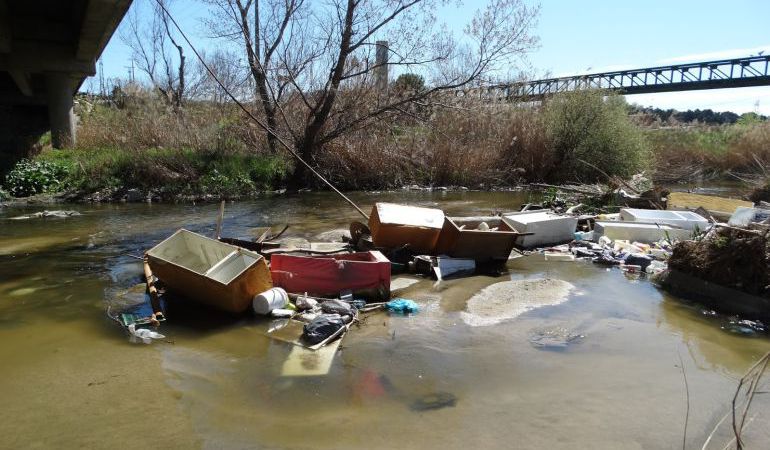A CDW plant is a centre where the building and digging wastes are collected, managed and valued. The management and production of this waste is regulated by the law called Real Decreto 105/2008 which establishes the legal framework for the production and management of building and demolition waste. Therefore, it is ensured the waste is treated correctly and environmentally-friendly.
All the activities done in a CDW plant are regulated by the law mentioned in the previous paragraph; they are basically to receive this waste, to value and separate it in order to use it again. Nowadays, the possibility of recycling daily products –such as plastic and glass- is very widespread. Concerning to CDW plants, the possibility of recycling is wider as, apart from the materials named previously (and also wood), almost everything can be treated and used again, except for the dangerous waste, such as asbestos, sprays, and other dangerous waste which may be in the rubble in small quantities. This dangerous waste must be taken to other plants where it is manipulated by qualified workers in order to receive the correct treatment.
The different materials collected by sifting are perfect for pipes and cables to bury with, and suitable for plant ground. The ground asphalt can be used to rebuild paths and also like sediment. Bricks, ceramic tiles and other ceramic materials can be sifted and, then, used as a material to fill up with, like sediment and to rebuild rural paths. The sifted concrete can be used in different ways: Firstly, as an arid material in the process of making concrete (regulated by EHE-08). This process is quite unusual in Spain because the quality of arid materials is really good and, also, the use of arid materials to make concrete would mean to have to use more cement to make concrete stronger and, consequently, the cost would increase. However, in other countries, like the Netherlands, where the arid materials are not so good, it is common to make concrete with a high quantity of recycled materials. Secondly, the sifted concrete is quite good being used in small stones, and also a perfect material used underground and above ground, as it has been tested successfully in previous times.

Picture 1: non-classified rubble, classification of waste, arid materials been sifted.
The measures given in the Real Decreto to ensure the correct treatment of rubble are: a survey (included in the building project execution) of how the waste generated after a building work will be managed, estimating the materials used in the work; an estimation of the cost expected for the management of the waste. This will be in an independent chapter of the estimate; and finally, to get the documents justifying that the demolition and construction waste has been managed by an authorised agent. Moreover, a bail should be disposed to ensure the waste has been legally managed.
The producer and the holder of waste are also differentiated in such law. On the one hand, the producer is either the physical or legal person holding a building licence, or the owner of the property where the work is going to be done. On the other hand, the holder of waste is a physical or legal person who, having the waste, is not authorised to manage it. This person can be the manager of the work, a building contractor, a subcontractor, or a self-employed.
The person holding the waste must deliver it to an authorised agent, who will use it, in this order, for reuse, recycling or other ways to value it. Furthermore, the holder is obliged to pay for the management cost, and also to send the producer all the certificates and other supporting documents about the management of such waste.
The regional and local governments are the responsible of making the regulations comply about managing demolition and construction waste. To get this, they need to authorise, watch, and inspect the production. Furthermore, the public administration will promote the use of this kind of materials from recycling building waste, especially for restoration of diminished green spaces. Apart from this, they will promote the use of recycled materials in new public infrastructures, such as the arid ones, saving natural resources.
Even today, it is possible to see a lot of rubble dumped in the surroundings of towns and cities with no control, although it is more and more common to take this kind of waste to recycling plants to be classified and reused. Likewise, there are a lot of dumping sites (looking like legal recycling plants) for building waste where the materials are not classified and reused afterwards. The amount of material recycled in this kind of plants is increasing, but it is still very low. However, this type of material can be much more used than it is used nowadays. This material is technically quite good for using, and very cheap. Also, the plants where these materials are stored are usually close to towns and cities, so it is more economical to carry, especially the arid materials.

Picture 2: uncontrolled, dumped waste / classified, reused waste
This kind of plant is environmentally-friendly as it prevents contamination recycling and reusing all the demolition and construction waste, and reducing the use of natural resources. As a result, the area where the plant stays will be more ecologically self-sufficient and, consequently, the ecological footprint will be reduced.
SERGIO TELLO GONZALEZ
Alumno de la ETSI Caminos, Canales y Puertos. Universidad Politécnica de Madrid
